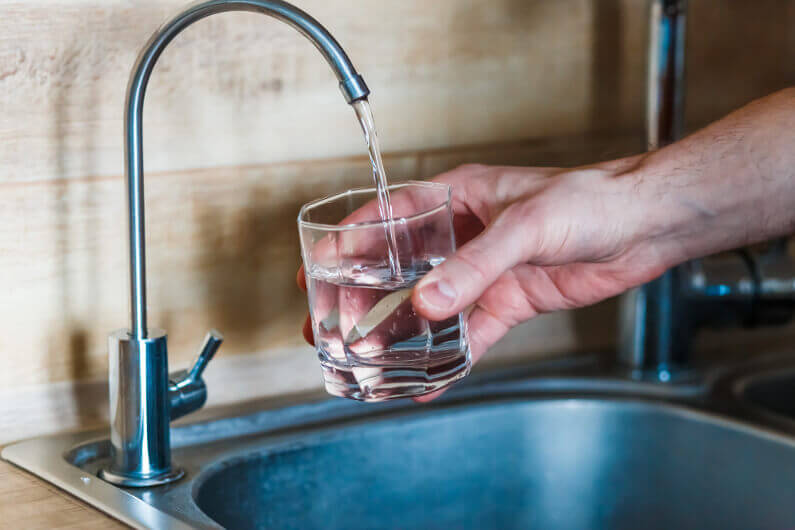A Sterling Plumbing Blog
Plumbing Articles from Columbus, OH
The Dangers of Drinking Moldy Water That Is Hiding in Your Sink

Mold is often a common sight in most homes. It may appear behind your washing machine, dishwasher, and the corners of your shower. Due to the nature of how mold grows and spreads, this is normal.
However, what’s not as common is mold growth in the interior of your drains, water pipes, and filters. It’s also a sign that you could be drinking moldy water.
Keep reading to learn more about the dangers of drinking mold-contaminated water and how to prevent this type of mold build-up.
How Does Mold Grow in Your Water System?
Mold is comprised of organic matter and needs three essential ingredients to survive: water, oxygen, and food — like most living things. This mold is spread via airborne mold spores that can travel pretty far, without much hindrance.
Mold will grow and spread at a rapid rate if it has all the components it needs to survive.
If you live in a more rural area and source your water from a well, mold in the water system is a little more common. This could point to a problem with your well cap and an inadequate seal.
But if you live in a city or suburb, it’s also possible for your water supply to become contaminated. This is often caused by high levels of oxygen and a build-up of organic food particles in your pipes and drains. If you use a paper filter cartridge, for example, this creates an environment for mold to grow and survive.
Common signs of mold growth in your water system include:
- A moldy smell coming from your taps when you run water
- An excessive build-up of mold at the base of your shower
- A build-up of a dirt-like substance that collects at the bottom and sides of your toilet
- Unusual mold growth in other areas of your home
Remember that mold has the ability to grow at a very rapid rate. Not only can it contaminate your water pipes, but also a water storage tank, and other water distribution systems you use.
The Dangers of Mold Exposure and Drinking Moldy Water
Short-term exposure to mold does not carry any serious health risks, aside from causing or inflaming certain allergies. But living with mold on a longer-term basis as well as ingesting it tells another story.
Mold exposure is also very dependent on the person exposed to it. Some people may be highly sensitive to mold exposure, while others show very little reaction.
However, some of the most common sensitivities to mold exposure include:
- Nasal stuffiness
- Throat irritation
- Persistent coughing
- Persistent headaches
- Wheezing
- Skin irritation
- Eye irritation
These symptoms are far worse in people who suffer from mold allergies. The same goes for people with autoimmune disorders and respiratory conditions, such as asthma or lung disease. Mold exposure may result in medical treatment.
In addition to this, mold is dangerous because it’s likely to harbor bacteria, chemicals, and harmful gasses. This is particularly dangerous if these compounds are found in the water you’re drinking.
Infections Caused by Mold
Mold is also known to cause or exacerbate certain infections. But this is particularly related to the toxic bacteria, chemicals, and gasses that mold can harbor.
Ingesting moldy water can cause instances of recurring bronchitis and other respiratory infections. It may also be responsible for causing fungal infections such as athlete’s foot and thrush when exposed to harmful strains of mold, over a long-term period.
Toxic Mold Syndrome
This is a syndrome that is developed over time due to the exposure of toxic mold, also known as black mold. This type of mold can live inside your drains and pipes, slowing building up over time if it’s left unseen to.
Toxic mold exposure has been linked to a number of worrying symptoms including memory loss, insomnia, confusion, and trouble concentrating. Studies have shown that, overall, exposure to black mold can lead to cognitive and emotional impairment.
How to Remove Mold From Your Pipes and Keep Them Clean
Your water system is a place that’s continuously wet and dark. There’s very little you can do about that, so this makes it impossible to continually keep mold at bay.
However, with some much-needed drain and pipe maintenance, you can greatly reduce your risk of mold exposure — and ingesting moldy water.
Here are a few DIY steps to remove mold from your water system and keep it clean:
- Step 1: Rinse your drains with household bleach — pour half a cup down each drain and allow it to sit for one hour
- Step 2: Then, boil your kettle and pour two full cups down each drain. Then flush it out by running your hot water tap for a few minutes
- Step 3: After this, pour a quarter-cup of baking soda down each drain and then one cup of vinegar. Allow it to sit for 15-minutes
- Step 4: Finally, boil your kettle again and pour two more cups of water down each drain, then run the hot water tap for a few minutes
Develop a maintenance plan and try to stick to it. It’s recommended that you use this mold-prevention method once a month to keep your water system clean.
Get Your Drains Inspected and Cleaned Here
At A Sterling Plumbing and Drains, we understand the dangers of drinking moldy water. We strive to keep your home water system clean, fully-functional, and 100% safe for you and your family.
If you’re in need of drain services — whether it’s inspection, cleaning, or repair, don’t hesitate to give us a call!
5 Comments
Submit a Comment
Schedule a Job Quote
Serving Columbus, Grove City, Gahanna, Reynoldsburg & Surrounding Area's
FREE ESTIMATES
a. sterling plumbing
Full Service Plumbing Columbus, Ohio
A Sterling Plumbing Sewer & Drain
3555 Groveport East Rd
Columbus, OH 43207
(614) 332-6656
or Send Us an Email Here.
© 2018-2024 ASterlingPlumbingColumbus.com
– All rights reserved. –
Information on this website may not be re-used without prior written consent from A Sterling Plumbing.
HOURS & LICENSE INFO
Monday-Friday: Open 24 Hours
Saturday: Open 24 Hours
Sunday: Open 24 Hours
Ohio Licensed, Bonded, Insured
OH Plumbing Contractors License # OL-26324





Blk and green mold built up inside my ceramic water dispenser, It took me a long time to realize. In hindsight I realized I had been drinking it for almost 9 months. I had many seemingly mysterious health issues and felt in agony by the time I discovered the mold in my water dispenser.
How did you recover from it? I just noticed I had been drinking from a water bottle in my kitchen on an almost daily basis and noticed green mold in it. I have been having an extended sinusitis. Now its making sense why I cant shake it. Did you see a Doctor? If so what did they do if anything to treat the mold exposure?
It’s horribly hot here in Venice Italy and so we are all drinking a lot more water. I have a Brita water jug in my fridge and have been really using it frequently. Well, my refrigerator has been acting up and things either freeze of get moldy, I am constantly throwing out two day old food because of the mold. I never dreamed my Brita would get moldy but this morning I woke and was in the bathroom 12 times….just when I think there is nothing left in me I start vomiting as well. Because I feared dehydration I was trying to rehydrate with the water from the Brita. While I was thinking through what I could have possibly ingested that made me so sick I took the lid off my Brita and there was scattered small amounts of red and yellow mold…I suspect that there must be some in the water that was had been drinking for days and gradually I overwhelmed my body. Can’t guarantee that is what is was, but a word to all Brita users, in this heat…wash your container frequently.
I need to know how to get mold out of the pipes coming IN, bringing the water into my home, so I have good water free of mold. Thanks
I have been unable to keep tap water and bottled water down for the past 2 years! It always comes back up! My family members have had the same issue. I have been using a filtered container to maintain. My mom even switched from certain brands of bottles water due to PFAs and what-nots being used to make the plastic. After reading this, I’m definitely going to go drop off a stool sample at my clinic lab. I have had a horrible bellyache on and off for a few weeks now. Hope it’s not H. pylori.